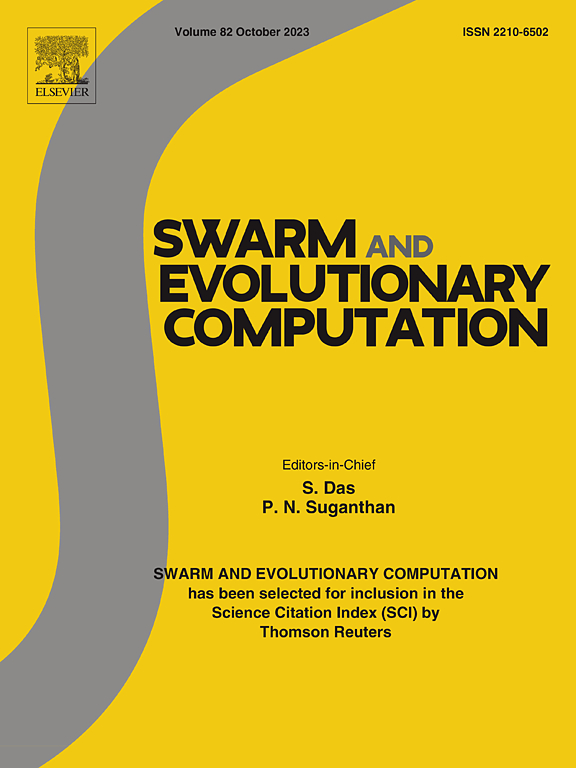A dual model-based evolutionary framework for dynamic large-scale sparse multiobjective optimization
IF 8.5
1区 计算机科学
Q1 COMPUTER SCIENCE, ARTIFICIAL INTELLIGENCE
引用次数: 0
Abstract
Recently, there has been a growing interest in dynamic multiobjective optimization problems (DMOPs). Although some evolutionary algorithms have been tailored for DMOPs, their effectiveness is limited when handling large-scale DMOPs, especially those characterized by sparsity, where most variables in Pareto-optimal solutions are equal to zero. To address this issue, this paper proposes a dual model-based evolutionary framework to solve dynamic large-scale sparse multiobjective optimization problems (DSMOPs). Specifically, the proposed framework addresses dynamic changes by predicting a new initial population for a static multiobjective optimization evolutionary algorithm in the new environment. Based on the idea of initial population prediction, the proposed framework transforms the large-scale variable prediction into the small-scale variable prediction, where support vector regression is introduced to predict the sparse distributions of the new initial population to reduce the decision space, and multilayer perceptron is performed on the reduced space to predict its continuous distributions. By integrating the two simplified predictions, a two-layer change response mechanism is constructed to ensure both the sparsity and quality of the obtained solutions. In addition, this paper designs the benchmark and real-world test problems to assess the performance of the proposed framework for tackling large-scale DMOPs. Experimental results demonstrate the superiority of the proposed framework compared with the six state-of-the-art algorithms.
基于双模型的动态大规模稀疏多目标优化进化框架
近年来,动态多目标优化问题(dops)受到越来越多的关注。尽管一些进化算法已经为dops量身定制,但它们在处理大规模dops时的有效性有限,特别是那些以稀疏性为特征的dops,其中大多数帕累托最优解中的变量等于零。为了解决这一问题,本文提出了一种基于双模型的进化框架来解决动态大规模稀疏多目标优化问题。具体而言,该框架通过预测新环境下静态多目标优化进化算法的新初始种群来解决动态变化问题。该框架基于初始种群预测的思想,将大尺度变量预测转化为小尺度变量预测,在小尺度变量预测中引入支持向量回归来预测新初始种群的稀疏分布以减小决策空间,并在减少的空间上使用多层感知器来预测其连续分布。通过整合两种简化预测,构建了一种两层变化响应机制,以保证得到的解的稀疏性和质量。此外,本文还设计了基准测试和实际测试问题,以评估所提出的框架在处理大规模dops方面的性能。实验结果表明,与现有的六种算法相比,该框架具有一定的优越性。
本文章由计算机程序翻译,如有差异,请以英文原文为准。
求助全文
约1分钟内获得全文
求助全文
来源期刊

Swarm and Evolutionary Computation
COMPUTER SCIENCE, ARTIFICIAL INTELLIGENCEC-COMPUTER SCIENCE, THEORY & METHODS
CiteScore
16.00
自引率
12.00%
发文量
169
期刊介绍:
Swarm and Evolutionary Computation is a pioneering peer-reviewed journal focused on the latest research and advancements in nature-inspired intelligent computation using swarm and evolutionary algorithms. It covers theoretical, experimental, and practical aspects of these paradigms and their hybrids, promoting interdisciplinary research. The journal prioritizes the publication of high-quality, original articles that push the boundaries of evolutionary computation and swarm intelligence. Additionally, it welcomes survey papers on current topics and novel applications. Topics of interest include but are not limited to: Genetic Algorithms, and Genetic Programming, Evolution Strategies, and Evolutionary Programming, Differential Evolution, Artificial Immune Systems, Particle Swarms, Ant Colony, Bacterial Foraging, Artificial Bees, Fireflies Algorithm, Harmony Search, Artificial Life, Digital Organisms, Estimation of Distribution Algorithms, Stochastic Diffusion Search, Quantum Computing, Nano Computing, Membrane Computing, Human-centric Computing, Hybridization of Algorithms, Memetic Computing, Autonomic Computing, Self-organizing systems, Combinatorial, Discrete, Binary, Constrained, Multi-objective, Multi-modal, Dynamic, and Large-scale Optimization.
 求助内容:
求助内容: 应助结果提醒方式:
应助结果提醒方式:


